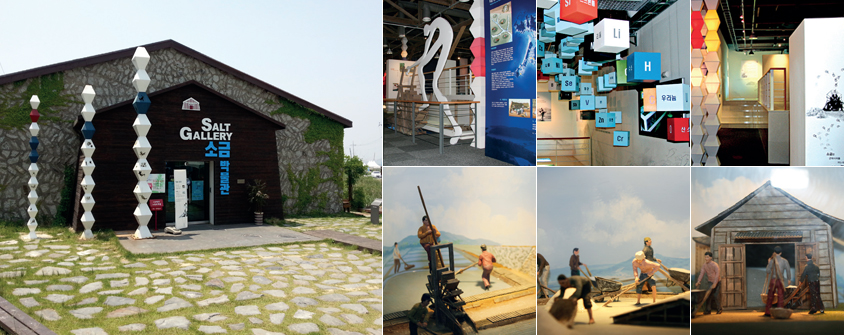Salt Museum
> Areas of Business > Tertiary Industry > Salt Museum
Meet the history of salt that has been side-by-side with the mankind. Salt that is indispensable to our mankind!

The first salt museum in Korea
Meet the history of salt that has been side-by-side with the mankind.
Salt that is indispensable to our mankind!!
Salt Museum Building (Registered Cultural Property No. 361) is a stone salt warehouse built in 1953. The old remains are well preserved, making it the valuable relic of the history of the salt pond, and it holds significant implications as the modern stone architecture. Inside the museum, visitors can get a glimpse of the history and culture of salt, the beneficial information on salt such as minerals and Natural Sea Salts, the daily routines of the salt makers and the production process of the Natural Sea Salts
Sea – the place where life began
Sea was born with the birth of the earth. That’s where life was born, and even human lives are conceived in the amniotic fluid with the equivalent concentration of seawater. All creatures remember what the sea is like.
Salt – Opening the mind of the mankind
History of salt – In history, salt has always been at the central axis, because, in the days when salt was not as common as it is now, it was very important to be used as the main staple. That is why important trade routes were built to trade salt, an alliance was established, and even a revolution took place.
Salt and Culture
Discover the salt culture found in Israel, Mexico, Southeast Asia, Egypt and China. Salt has long been represented as a symbol of cleanliness and divinity, as people believed that it has the power to prevent meat from going bad and maintain human health and vitality.
How the wise ancestors used salt
Salt is used not only for seasoning but also for various purposes in our life. This can be seen in the lives of our ancestors, enabling us to get a glimpse of their wisdom in the old days.
Salt equals mineral
Healing power of Natural Sea Salt
Here, various kinds of salts are defined with the description of their substances, roles, and efficacy.
Relationship between Natural Sea Salts and Mineral
Here, any misunderstanding toward the salt is corrected and find out why we should take the Natural Sea Salt.
Treasure in Taepyung Salt Farm
Check out the salt produced in Taepyung Salt Farm, salt makers’ daily routines and their ideas.
Natural Sea Salt production procedure
Check out the production process of the Natural Sea Salt from the seawater stocking to the crystallization field, storage, and packing at a glance.
| Opening hours | 09:00 AM – 06:00 PM (Admission allowed by 30 minutes before closing) |
|---|---|
| Curator | Twice a day at 11:00 AM and 3:00 PM (for groups of 30 persons or more, advance reservations are available) |
| Closed on | Open throughout the year |
| Admission fee | Adults 3,000 won / Children 1,500 won (Free for those aged 65 years or older, men of national merit, pre-schoolers) |
| Contact | 061-275-0829 |




